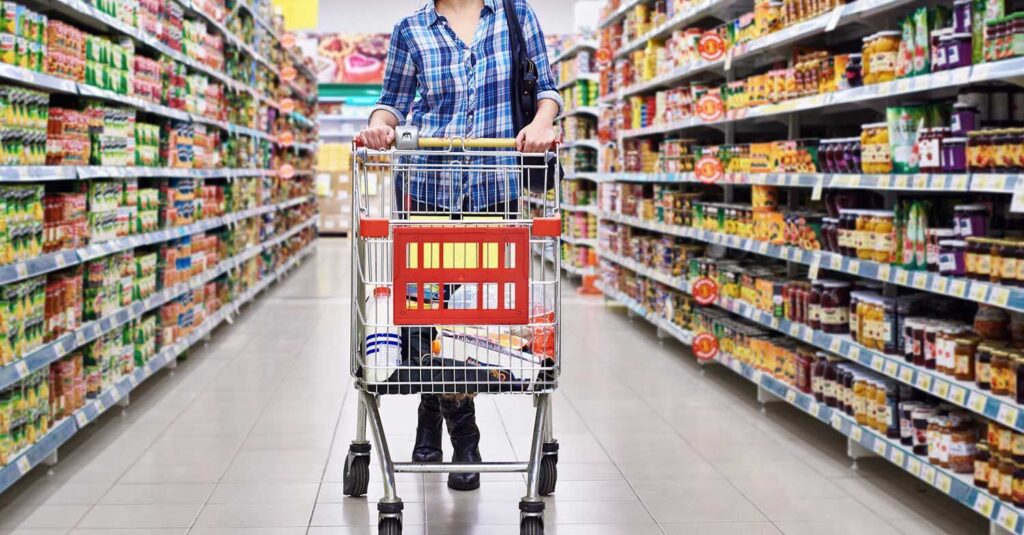Why Are Your Groceries So Expensive? An Ultimate Guide
Eggs, milk, bread, ground beef, butter—prices at the grocery store seem to be going up, don’t they? Especially for folks who spend a big chunk of their income on food, even a little price shock can have huge effects. Grocery prices, which used to tick up by just 1 or 2% a year, have started jumping to more like 13%. It’s a real sticker shock on store shelves, and you probably don’t need me to remind you. Everyone’s quick to blame COVID and broader inflation, and while those are certainly part of the explanation, I think there’s actually something bigger going on here. We’re going to dive into our food system, this vast, complicated, almost magical system that nourishes so many of us, bringing food from all corners of the world to our grocery store shelves. Then, we’ll look at the corporations behind it all, trying to understand their incentives, their power, and what they might have to do with these rising prices. Ultimately, I want to figure out what, or who, is truly behind this massive increase in grocery store prices.
The Long Journey of Our Food: From Ancient Trade to Global Supply Chains
Imagine, if you will, about 8,000 years ago, in what we now call Syria and Iraq. You’d find humans doing something pretty revolutionary for the time: they were growing food, and not just enough for themselves, but a surplus. And then, they started trading it with other folks who also had more than they needed. This was new, truly. If one group lived near a salt mine and another grew wheat, they’d both make a surplus, swap their goods, and both would end up better off. It was a super basic idea, but it changed everything.
Humans began doing this on a more and more massive scale, crossing seas and deserts, even building empires just to move goods, share tools, and spread ideas. The collective human focus, it seems, became: how do we do this better, bigger? We invented technology to improve it, we fought wars over it, we created money and companies and laws—entire systems, really—just to trade more stuff with more people. Trade was changing the world, and honestly, a lot of human history is the history of trade. It’s what spread Arabic math and Chinese inventions, brought tomatoes to Italy, chilies to Asia, corn to Africa, and coffee to Europe in the 1500s, blowing everyone’s minds and contributing to a whole revolution in thinking. Good coffee, you know?
But despite all this global trade, this improvement, this connecting the world and bringing flavors everywhere, food still remained quite expensive. You still had to work really hard just to feed yourself and your family. Agriculture and food preparation demanded immense physical labor, often involving entire households just to produce enough calories to survive. We even have data from the late 1700s showing that people in Britain spent about 75% of their income just feeding themselves. Around the same time in France, they were spending about 70% of their income on bread alone. Can you imagine?
Historical Food Expenditure as Percentage of Income
Soon, though, that started changing, and fast. Look at the graph above. By the year 1900, a household might be spending more like 42% of their income on food. Then, in the 1930s, it dropped to 34%, and it just kept falling after World War II. Something really dramatic shifted in the global economy. The US and its allies built a global economic system designed to connect the globe. The thinking, I suppose, was that if everyone’s economy was connected, they’d all benefit too much to fight each other. And America, well, it wanted to set the rules for everyone, and it successfully did.
With this new system came a whole new level of efficiency and connection. Think about those magical boxes, shipping containers, that can go seamlessly from ships to trains to trucks, drastically cutting costs and loading time. The world standardized around everything: railroad sizes, pallet sizes, paper sizes, barcodes, shoe sizes, screw sizes. It’s invisible stuff, this isn’t sexy, but it’s transformative. The whole idea being that if everyone’s using the same system, everything becomes more efficient, and trade gets better. Now, a tractor part made in South Korea snaps in nicely to a tractor in Kansas. Then there was the US dollar, which everyone could use as the global currency, along with international agreements that laid out the rules for modern trade. Suddenly, it was like the 1950s, and the whole world was being stitched together in ways our ancient grain trading ancestors could have never imagined. This is why today, almost everything you touch has probably gone to more countries than you have, traversing a huge network of the global economy we call the supply chain. An iPhone, for example, might travel to 43 countries before it ends up in your hands.
But food isn’t an iPhone, is it? Food is squishy and perishable and often needs to be refrigerated. It doesn’t go through the same kind of advanced global supply chain that other stuff does, right? Wrong, actually.
Take a tomato. You can buy a beautiful, locally grown tomato at a farmer’s market for, say, six bucks. That’s a $6 tomato, grown just a few miles from your house. Then, you have these other tomatoes, which don’t look all that different, maybe a little more uniform. These are tomatoes that came from the global economy. They’re all basically the exact same size, and they’ve come to you from very far away, often not even in this country. While the US does grow a lot of tomatoes, especially in California, most of our tomatoes are actually grown in Mexico, with 4 billion pounds a year coming into the US.
So, let’s trace the journey of a tomato from northern Mexico. They’re often picked while still green, not ripe yet, usually by hand, and then loaded into trucks. A tomato like this will often go into a sealed room where they’re gassed with ethylene to ripen them. Ethylene is just a naturally occurring hormone that helps ripen these guys, and they want them all to ripen at the same time, right as they get to the grocery store. But they have a long way to go. So, they’re pumped with this gas, and then, if they’re going into cans (which a lot of tomatoes do), they go through industrial factory wizardry. But for the ones that are going to end up fresh, they’re on a truck headed north.
They end up in a nearby city, probably Culiacán, in a big facility where they’re sorted, chilled, and then put on big pallets. They get back onto a truck, which, by the way, all of these trucks are refrigerated—that’s a big logistical challenge, making sure these things don’t get too hot or cold. Now, the truck is heading north. It gets to the US-Mexico border. This is where people go back and forth, but there’s a special border crossing just for trucks. Our tomatoes are in one of these. It clears customs, and then it probably ends up at one of these transfer stations, where the trailer might be transferred onto another truck to an American driver who will take it from there. The tomatoes are now in the United States. Once in the US, they might be re-ripened and repackaged, and they eventually take a long haul trip on America’s freeways, ending up at a distribution center, perhaps one in Illinois. Here, tucked into the endless expanse of farmland, is this massive building surrounded by cargo trucks. The tomatoes are unloaded, scanned for inventory, repackaged, and then they’re back on the road, headed towards the grocery store. This whole journey? About 9 days, 1,000 kilometers, or 620 miles. And the tomatoes are finally stacked in the vegetable aisle, ready for you to buy a pound for $2, bring them home, chop them up, and throw them into a sauce. Bon appétit.
That was crazy, right? Like, that whole journey. Your tomatoes came all the way from a farm in Mexico, and they somehow made it to the grocery store without being smashed or going bad, and are somehow significantly cheaper than a local one. How does that work? How does that make any sense? And it’s not just tomatoes. Avocados, for instance, are picked by hand in southern Mexico, sorted, chilled, trucked, and displayed in the northeast of the United States in the dead of winter for like three bucks. Most of our vegetables in the United States, about 60%, come from other countries. And of course, you can imagine it gets even more complicated with animal products: eggs, milk, meat. But this is your food system, our food system. The majority of us participate in this food system.
- Ancient Origins of Trade: Food surplus led to early trade, driving human connection and technological spread.
- Historical Food Costs: Historically, food consumed a vast majority of household income (e.g., 70-75% in 18th century Britain/France).
- Post-WWII Global System: Standardization (e.g., shipping containers, pallet sizes) and a global currency (US dollar) drastically increased efficiency and reduced food costs.
- Complex Supply Chains: Modern food travels vast distances through intricate supply chains, involving multiple stages like picking, gassing (for ripening), chilling, and multi-modal transport.
- Global Sourcing: A significant portion of US produce, like tomatoes (mostly from Mexico) and other vegetables (60% from other countries), is sourced internationally due to efficiency and cost.
The Price Hike: Two Key Reasons
So, why is food suddenly way more expensive now? Well, there are two main answers to that question. The first one will probably make a lot of intuitive sense, especially since we just traced the journey of a tomato. The second one, though, might just boil your blood.
Reason One: Supply Chain Shocks and Fragility
Something happens along the way. Let’s go back to that map of the tomato’s journey. Your tomatoes passed through farmers, packagers, cold storage, drivers, customs brokers, international trade treaties, warehouses, wholesalers, grocery stores. If any part of this massive system breaks, or becomes more expensive, or if there’s a power outage, a storm, a frost, a drought, or gas prices spike, or workers go on strike, or a new tariff is introduced, any one of these steps can become more expensive. And guess who pays that price? You, the final customer. We call this a supply chain shock or shortage. It’s kind of ironic, isn’t it, that the very system that makes food more accessible and cheaper is also the same system that makes our prices so fragile?
And over the last four years, well, there’s been a lot of that. COVID, obviously, was just the beginning of a domino effect. There was a drought in the Mediterranean, so olive oil prices went up. Climate related issues have really messed up fresh produce at large. Sometimes climate affects how much we can grow, but also sometimes climate then interacts with things like disease outbreaks. A freeze in Texas, for example, wiped out a bunch of citrus. Ranchers are experiencing some of the worst conditions ever because of drought, with ground not fit for grazing, forcing them to cull their herds because it’s more economical than feeding them.
Russia’s invasion of Ukraine messed with a lot of industries. The war spiked wheat prices there for a little bit, and also spiked fertilizer prices. The issue is, Russia controls one type of fertilizer, but not two others, which meant farmers had to retool all their systems to switch to the other fertilizers, leading to a run on those. Palm oil got really screwed up for a while because Indonesia decided to temporarily ban exports as prices were increasing so much, wanting to ensure enough domestic supply. This was also, you know, kind of in the wake of Ukraine, so vegetable oil prices were up. A hurricane in Florida messed with orange groves. The Houthi rebels in Yemen are firing rockets at merchant ships, which are the lifeblood of the global economy. Canada, the largest producer of canola oil, had a big drought, which dropped supply.
During the pandemic, there were massive COVID outbreaks in meat packing plants, slowing down line speeds because there were fewer workers, meaning less meat was getting slaughtered and packaged. And of course, there were shortages in random things like packaging, trucking, cold storage, and shipping containers. During COVID, production of aluminum cans was lower because factories were closed, but then trade wars over aluminum also affected cans, so for a while, soda and beer were being affected. Each shock to the system triggers a reverberation through the rest of the system, which makes things more expensive and unpredictable. The price goes up, and eventually, the price of your final product, the thing you see on the grocery aisle, has gone up. No one’s disputing that supply chain shocks are a major reason why prices have gone up. But this isn’t actually the full explanation. There’s something bigger going on here.
- Supply Chain Fragility: The complex global food system is vulnerable to disruptions at any stage (e.g., farming, packaging, transport, customs).
- Diverse Shocks: Recent price increases are linked to a multitude of factors, including:
- Natural Disasters/Climate: Droughts (Mediterranean, Texas, Canada), freezes, hurricanes affecting crops and livestock.
- Geopolitical Conflicts: Russia-Ukraine war impacting wheat and fertilizer prices, Houthi attacks disrupting shipping.
- Trade Policies: Indonesia’s palm oil export ban, aluminum trade wars.
- Pandemic Impacts: Labor shortages (meat processing), reduced production (aluminum cans), and general logistics issues (packaging, trucking, shipping containers).
- Ripple Effect: Each shock creates a ripple effect, increasing costs and unpredictability throughout the supply chain, ultimately passed on to the consumer.
Reason Two: Corporate Profits and Market Consolidation
This gets to my second answer to the question of why grocery prices are more expensive. I’ll just say it upfront here: we’ve all been, well, kind of tricked. And there are people making a lot of money off of us being tricked about prices. Basically, during COVID, I think there was a reckoning. Customers were pretty understanding when companies said, “Hey, you’re going through hard times, and so are we. Our costs are going up.” There was kind of this reset. The American consumer had gotten so used to having a really cheap thing delivered to their door in like two hours, right?
In Econ 101, they teach you about a supply and demand curve. As you increase prices, the number of units you sell goes down. What you’re trying to do is maximize those two things, selling as many products as you can make for as much as possible. That’s, you know, the invisible hand of the market at work. But what companies realized is they could inch prices up and see no, or very little, reduction in consumer demand. And so, they just kept doing it. This will be clear very soon because there are a lot of examples of this, but the best one that’s on my mind is eggs. The egg price is out of control. Eggs are insanely expensive right now. Maybe by the time you’re watching this, they will have gone down a little bit, but over the last three or four years, egg prices have gone crazy.
And what’s the explanation we’re all hearing? “Yes, the bird flu! Culling millions of hens! Bird flu, bird flu, bird flu!” Already, more than 90 million birds have been killed since the outbreak started. I mean, if you’re an egg producer, and suddenly there’s an outbreak of bird flu on all your farms, that’s a huge deal. That would be, like, really terrible for your business, wouldn’t it? You’d be thinking, “Man, our product is being killed by a flu.”
Egg Prices vs. Producer Profits
Wait a minute, though. The US’s biggest egg producer’s profits tripled as prices soared. Triple profits for the biggest egg producer? Oh, and if you look at the biggest egg producer’s stock price, you see it going nuts right around the time the avian flu is happening. Time to get out their annual report. Cal-Maine Foods Inc., a publicly traded company, must disclose all its financials, which means we can get a little more insight into how they fared during this time when there was a crisis in our egg economy, and all of us were paying more than double the price for a dozen eggs. This is 2023, and it looks like its shareholders got paid $250 million in profits.
It’s right in the middle of the bird flu crisis. You wouldn’t think they would be profiting that much, would you? Is $250 million a lot? Let’s graph the dividends, the profits paid out to shareholders. Whoa. Okay, well, 2023 was a great year for the largest egg producer in the United States, despite all this avian flu. In 2023, they paid $250 million. The year before, they paid $6 million. So, they had a 40 times increase in the profits they paid out to their shareholders, right in the heart of when all of us were going to restaurants and seeing signs saying, “We’re raising prices on eggs because there’s a bird flu, so we have to pay more.” But the company making the eggs is profiting a lot more money. It’s not just revenue; it’s not like they’re making more money and their costs have increased a bunch. No, they are profiting. They are making way more money after all of their costs, and we are all paying more. Oh, and this year, 2025, their profits are up 342% in Q2.
US Egg Production vs. Price During Avian Flu
Just to drive this home, let’s put these two graphs next to each other. This one shows the price for a dozen eggs; it’s gone up a ton because of bird flu. And this one shows profits for shareholders of Cal-Maine Foods, going up at the same time. So, these graphs tell a story of a company that was able to raise prices more than what they needed to cover their costs, and they were somehow able to do that. Can we just look at the supply of eggs in the United States real quick? This graph shows the price going up. Now, let’s draw on the number of eggs produced in the United States during this time. Here’s the outbreak of the avian flu, early 2023. If I were guessing, I hadn’t seen this chart before, I would imagine it would look something like: eggs, eggs, eggs, flu happens, production of eggs plummets. When there’s less supply, prices have to go up, and that’s why prices went up. Now, let’s draw in the real shape. Again, the number of eggs produced in the United States: boom, it kind of barely dips. Yes, avian flu was a real thing. I’m not, like, drawing some conspiracy theory here that this isn’t real. But this crisis was as much about storytelling as it was about supply and demand. We all accepted way higher prices because of these signs, because of all this news. And in fact, thanks to COVID, we were kind of used to hearing about supply chains and paying higher prices and waiting longer because of something that’s out of our control. This is the driver of inflation, right?
But what this story tells is that there’s a company that, by the way, controls 25% of the market. They are a huge player, the largest player by far in the egg economy, that has the ability to raise prices even when they don’t need to increase costs. And that company, by the way, if you chart how many eggs they were making during the crisis, they were actually making more eggs and just selling them at a way higher price. So, of course, their profits tripled. Of course, their shareholders made off with huge dividends. You can read a lot more about this in a couple of really good reports that were very helpful for our reporting, one of which concludes that corporations have used this outbreak, the avian flu, as a smoke screen for raising prices beyond what was necessary to cover any rising costs.
This is the kind of stuff that happens when one company owns a huge portion of an industry. They just have a ton of control, and they’re able to manipulate the market that is supposed to be a competitive space where all the firms compete for customers by lowering their prices as much as they possibly can. But our modern food system has become more and more consolidated. Four firms handle 85% of all beef processing in the US. Three companies control 78% of all pasta. Two firms own 70% of the canned tuna industry. One company dominates seed genetics. And 70% of all grocery stores flow through just four chains. This level of consolidation means that companies don’t really compete on prices. They match prices. And when there is a crisis, they’re able to take advantage of that to help spread the narrative and signal to the rest of us that prices have gone up because of this crisis, when really they’re just patting their bottom line.
There are a bunch of lawsuits happening right now because of this. McDonald’s is suing meat companies for colluding to keep prices high. Frozen potatoes for your French fries are also very consolidated, also with some price manipulation allegations there. A big turkey producer is in the middle of a price fixing scandal; they’ve had to pay out settlements, $32 million here, $4 million there. I mean, this is kind of a cost of doing business when you are a big industrial food producer and you use your power to cash in. So, we’ve been told a story that these crises, COVID and supply chain shocks, are at the root of inflation, of prices going up. But there’s now pretty compelling evidence that corporate profits, their ability to take advantage of these situations to raise prices above where they need to be, is a major driver of inflation. Meaning, we’re paying more money, and we’re making these companies way richer. Corporate profits are at an all time high, despite some volatility in the economy. Last year, margins reached over 16%, which is the highest on record since 1950. And it’s not just in food; it’s across all sectors. The CFO of Hershey in 2023 said on an earnings call to the company’s shareholders, “Pricing and productivity gains more than offset inflation and higher manufacturing and overhead costs.” In non Wall Street speak, that says, “We increased our prices well above what our increased costs were.” Like, our costs for sugar, cocoa, etc., have gone up, but we have been able to not only pass all of those costs on to consumers but then some, increasing our profit margins. Hershey’s wasn’t the only company to say this; virtually the vast majority of S&P 500 companies said this. Frito-Lay and PepsiCo, for example, did the same thing, saying, “We’ve been able to rapidly increase our pricing actions,” which just means increasing prices. So, profits are soaring while a family of four surviving on a thrifty food plan is seeing their costs for food increase by 30% or more over the last few years. More and more are turning to government programs, and so now our taxpayer dollars are going to help inflated prices to make shareholders rich. It’s not a good setup. It’s not a good set of incentives. It’s not a free market. This isn’t good.
- Exploiting Crises: Companies, particularly in consolidated markets, may use supply chain shocks as a “smoke screen” to raise prices beyond what’s necessary to cover increased costs.
- Egg Market Example: Despite the avian flu, a major egg producer (Cal-Maine Foods) saw profits increase dramatically (40x in one year), indicating price increases outpaced cost increases.
- Market Consolidation: Industries like beef processing (4 firms, 85%), pasta (3 firms, 78%), canned tuna (2 firms, 70%), and grocery retail (4 chains, 70%) are highly consolidated.
- Lack of Competition: High consolidation leads to price matching rather than competitive pricing, allowing firms to manipulate the market.
- Record Profits: Corporate profits across various sectors, including food, have reached all time highs, with companies explicitly stating that pricing actions exceeded inflation and cost increases.
- Consumer Burden: Consumers, especially low income families, bear the brunt of these increased prices, sometimes relying on government assistance, which indirectly subsidizes corporate profits.
Solutions and the Path Forward: Reclaiming Our Food System
Luckily, there is some hope here. The Department of Justice is already investigating this egg price fixing allegation. Cal-Maine, the largest supplier of eggs in the US, has been accused of this in previous disease outbreaks and is now under federal investigation related to the sky high prices consumers saw for several months.
But what really needs to happen, I think, is a breaking up of these food companies that have so much power in the market. Food isn’t like other things. It’s not like vacations and cars and things that are discretionary. It is our basic survival. We have antitrust laws, we have other laws that protect small businesses, and this current crisis is rejuvenating a discourse around seeing what the government can do to actually make prices more affordable to everyday Americans. There’s also a necessary reckoning with how reliant we are on these far flung supply chains. COVID really started this, and you’re starting to see more and more stuff come regional and local.
Mexico, for instance, is experimenting with the government stepping in and putting a price control for a basic basket of food, using their power to negotiate with food corporations to keep prices affordable for the basics. One place where grocery prices really didn’t increase all that much was Mexico, and that’s because Claudia Sheinbaum’s administration did this thing called “Canasta Básica,” which translates to “basic basket.” For the equivalent of about $40, you can get enough food to feed your family: rice, beef, a couple of vegetables, a gallon of milk—these basics. And in fact, that price has come down by like 12% over the past year. She did this; it’s effectively a price control, but it’s voluntary. Walmart of Mexico, for example, participates in this program. She got a bunch of farmers and suppliers and retailers to all buy into this program. They negotiated this big deal, and they all offer a basic basket of goods for a low price for Mexican families. She just used, you know, kind of the weight of the government to say, “Hey, I think groceries should be cheaper for Mexicans, and how can we work together to do it?”
So, there is some movement happening here. The reality is, our food system is amazing. It has made food much cheaper than it was, but it has some real weaknesses. Weaknesses that are being exposed in the last few years, and that a lot of people are feeling when they go to the grocery store. Those are market failures, and that is where the government steps in to ensure that our food system works for the consumers, the people who need to be able to rely on affordable food, and not just for the corporations that provide it.
- Legal Action: The Department of Justice is investigating alleged price fixing in the egg industry, indicating potential accountability for corporate practices.
- Antitrust Enforcement: A key solution involves breaking up highly consolidated food companies to foster competition and prevent market manipulation, recognizing food as a basic necessity.
- Regional/Local Sourcing: A shift towards more regional and local food sourcing can reduce reliance on fragile, far flung global supply chains.
- Government Intervention (Price Controls/Negotiation): Mexico’s “Canasta Básica” program demonstrates how government can voluntarily negotiate with suppliers to provide essential foods at affordable, stable prices.
- Addressing Market Failures: Government intervention is crucial to ensure the food system serves consumers’ need for affordable food, rather than solely benefiting corporations.
Our Plates, Our Prices: A Complex Reality
We’ve explored the intricate reasons behind the rising cost of groceries, peeling back the layers of our global food system. Historically, food was a massive expense, but modern trade and standardization made it incredibly cheap and accessible. However, this efficiency came with a hidden fragility, making us vulnerable to supply chain shocks from climate disasters, geopolitical conflicts, and even pandemic related disruptions. Crucially, we’ve seen compelling evidence that beyond these shocks, corporate profits, fueled by market consolidation and a lack of true competition, play a significant role in inflating prices. Companies may be leveraging crises as a pretext to increase margins, as the egg industry example vividly illustrates. Ultimately, addressing these issues may require stronger antitrust enforcement, a move towards more localized food systems, and perhaps even government intervention to ensure food remains affordable for everyone, not just a source of soaring profits.
Key Takeaways
- Modern food systems, while efficient, are highly susceptible to supply chain shocks (e.g., climate events, conflicts, logistics issues), which directly impact consumer prices.
- Corporate profits and market consolidation are significant drivers of rising food costs, with evidence suggesting companies raise prices beyond what’s necessary to cover increased expenses.
- Industries like egg production, beef processing, and grocery retail are dominated by a few large firms, leading to price matching over genuine competition.
- Solutions may include stronger antitrust enforcement to break up monopolies, a shift towards more regional food sourcing, and government initiatives like Mexico’s “basic basket” program to ensure affordability.
- The current situation highlights market failures where the food system prioritizes corporate profits over consumer access to affordable basic necessities.





